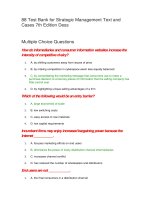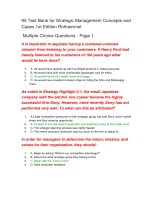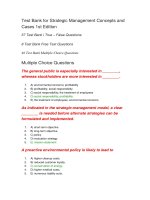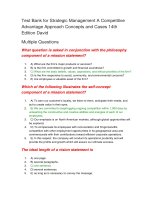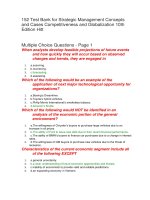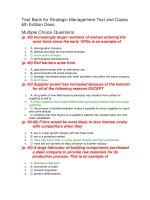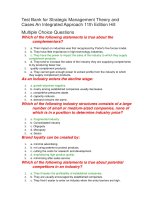Hospitality strategic management concepts and cases (second edition)
Bạn đang xem bản rút gọn của tài liệu. Xem và tải ngay bản đầy đủ của tài liệu tại đây (10.14 MB, 698 trang )
ffirs.indd ivffirs.indd iv 2/22/09 11:16:59 AM2/22/09 11:16:59 AM
Hospitality Strategic
Management
CONCEPTS and CASES
SECOND EDITION
CATHY A. ENZ
JOHN WILEY & SONS, INC.
ffirs.indd iffirs.indd i 2/22/09 11:16:48 AM2/22/09 11:16:48 AM
This book is printed on acid-free paper.
ϱ
Copyright © 2010, 2005 by John Wiley & Sons, Inc. All rights reserved
Published by John Wiley & Sons, Inc., Hoboken, New Jersey.
Published simultaneously in Canada.
No part of this publication may be reproduced, stored in a retrieval system, or transmitted in any form or by any means,
electronic, mechanical, photocopying, recording, scanning, or otherwise, except as permitted under Section 107 or 108
of the 1976 United States Copyright Act, without either the prior written permission of the Publisher, or authorization
through payment of the appropriate per-copy fee to the Copyright Clearance Center, Inc., 222 Rosewood Drive,
Danvers, MA 01923, 978-750-8400, fax 978-646-8600, or on the web at www.copyright.com. Requests to the Publisher
for permission should be addressed to the Permissions Department, John Wiley & Sons, Inc., 111 River Street, Hoboken,
NJ 07030, 201-748-6011, fax 201-748-6008, or online at />Limit of Liability/Disclaimer of Warranty: While the publisher and author have used their best efforts in preparing this
book, they make no representations or warranties with respect to the accuracy or completeness of the contents of
this book and specifi cally disclaim any implied warranties of merchantability or fi tness for a particular purpose. No
warranty may be created or extended by sales representatives or written sales materials. The advice and strategies
contained herein may not be suitable for your situation. You should consult with a professional where appropriate.
Neither the publisher nor author shall be liable for any loss of profi t or any other commercial damages, including but
not limited to special, incidental, consequential, or other damages.
For general information on our other products and services, or technical support, please contact our Customer Care
Department within the United States at 800-762-2974, outside the United States at 317-572-3993 or fax 317-572-4002.
Wiley also publishes its books in a variety of electronic formats. Some content that appears in print may not be available
in electronic books.
For more information about Wiley products, visit our Web site at .
Library of Congress Cataloging-in-Publication Data
Enz, Cathy A., 1956-
Hospitality strategic management : concepts and cases / Cathy A. Enz. — 2nd ed.
p. cm.
Includes bibliographical references.
ISBN 978-0-470-08359-8 (cloth)
1. Hospitality industry—Management. 2. Strategic planning. I. Title.
TX911.3.M27E56 2009
647.94'068—dc22
2008021438
Printed in the United States of America
10 9 8 7 6 5 4 3 2 1
ffirs.indd iiffirs.indd ii 2/22/09 11:16:59 AM2/22/09 11:16:59 AM
Dedicated to my
parents Richard and Betty Enz,
two remarkable people
ffirs.indd iiiffirs.indd iii 2/22/09 11:16:59 AM2/22/09 11:16:59 AM
ffirs.indd ivffirs.indd iv 2/22/09 11:16:59 AM2/22/09 11:16:59 AM
CONTENTS
Preface xiii
About the Author xix
CHAPTER 1 Strategic Management 1
Introduction 3
The Origin of Strategic Management 5
The Traditional Perspective 6
The Organization as a Bundle of Resources: The Resource-Based View 9
The Organization as a Network of Stakeholders 11
The Strategic Management Process 13
Situation Analysis 16
Strategic Direction 16
Strategy Formulation 18
Strategy Implementation 19
Global Competitiveness in the Hospitality Industry 20
Variables Affecting Strategic Management 21
Strategic Thinking 21
Strategic Planning Can Drive out Strategic Thinking 22
Characteristics of Strategic Thinking 23
Motivating Managers and Employees to Think Strategically 27
ftoc.indd vftoc.indd v 2/23/09 7:30:47 PM2/23/09 7:30:47 PM
CONTENTS
vi
Strategic Management in the Hospitality Industry 28
The Foodservice Industry—The Players 28
The Lodging Industry—The Players 29
Key Points Summary 33
Review Questions 34
Critical Thinking and Application Questions 34
CHAPTER 2 The Environment and External Stakeholders 36
Introduction 38
Assessment of the Broad Environment 39
The Sociocultural Context 40
The Economic Context 47
The Political Context 48
The Technological Context 50
Change and Interdependence among the Broad Environmental Forces 54
Gathering Information on International Environments 56
Analysis of External Stakeholders and the Operating Environment 58
Porter’s Five Forces, Economic Power, and Industry Characteristics 59
External Stakeholders, Formal Power, and Political Infl uence 69
Managing the Operating Environment 70
Economic Actions 71
Political Strategies 72
Partnering with External Stakeholders 74
Key Points Summary 76
Review Questions 78
Critical Thinking and Application Questions 78
CHAPTER 3 Strategic Direction 80
Introduction 83
Creating a Strategic Direction 83
Key Infl uences on Direction 86
Mission Statements 89
ftoc.indd viftoc.indd vi 2/23/09 7:31:01 PM2/23/09 7:31:01 PM
vii
CONTENTS
Organizational Vision 94
Organizational Values 95
Social Responsibility 99
Enterprise Strategy 102
Ethical Frames of Reference 105
Codes of Ethics 108
Ethics in Global Environments 110
Key Points Summary 111
Review Questions 112
Critical Thinking and Application Questions 113
CHAPTER 4 Organizational Resources and
Competitive Advantage
114
Introduction 116
Internal Analysis and Competitive Advantage 117
Sustainable Competitive Advantage 117
Value-Adding Activities 120
The Value Chains of Winemakers 120
Value-Chain Activities 121
The Tourism Value Chain 124
Tangible and Intangible Resources 125
Resources and Capabilities 126
Financial Resources 127
Financial Ratios 128
Physical Resources 130
Architectural and Sustainable Design 131
Human-Based Resources 134
Strategic Leadership 134
Ownership and Management 140
Employees 143
Structure and Culture 144
ftoc.indd viiftoc.indd vii 2/23/09 7:31:02 PM2/23/09 7:31:02 PM
CONTENTS
viii
Knowledge-Based Resources 148
Internal Knowledge Creation and Organizational Learning 150
Knowledge Creation 150
Knowledge Creation and Interorganizational Relationships 152
General Organizational Resources 155
Patents, Copyrights, Trademarks, and Servicemarks 155
Brands and Organizational Reputation 156
Superior Relationships with Stakeholders 159
Key Points Summary 160
Review Questions 162
Critical Thinking and Application Questions 162
CHAPTER 5 Strategy Formulation at the Business-Unit Level 164
Introduction 167
Generic Business Strategies 167
Cost Leadership 172
Differentiation 179
Best Value 185
Focus 188
Competitive Dynamics 189
Strategies That Refl ect Competitive Dynamics 191
Resources, Industry Structure, and Firm Actions 197
Strategic Group Mapping 199
Developing a Strategic Group Map 200
Key Points Summary 201
Review Questions 202
Critical Thinking and Application Questions 203
CHAPTER 6 Corporate-Level Strategy and Restructuring 205
Introduction 207
Concentration Strategies 210
Advantages and Disadvantages of a Concentration Strategy 211
ftoc.indd viiiftoc.indd viii 2/23/09 7:31:02 PM2/23/09 7:31:02 PM
ix
CONTENTS
Vertical Integration Strategies 214
Advantages and Disadvantages of a Vertical Integration Strategy 216
Vertical Integration and Transaction Costs 217
Substitutes for Full Vertical Integration 219
Diversifi cation Strategies 220
Related Diversifi cation 220
The Creation of Synergy 222
Unrelated Diversifi cation 226
Mergers and Acquisitions 229
Consolidation 230
Merger Performance 232
Successful and Unsuccessful Mergers and Acquisitions 234
Strategic Restructuring 236
Turnaround Strategies and Downsizing 237
Refocusing Corporate Assets 239
Chapter 11 Reorganization 240
Leveraged Buyouts 242
Changes to Organizational Design 243
Portfolio Management 244
The Boston Consulting Group (BCG) Matrix 245
Destination Portfolio Analysis 247
Key Points Summary 247
Review Questions 249
Critical Thinking and Application Questions 250
CHAPTER 7 Strategy Implementation through
Interorganizational Relationships and Management
of Functional Resources
252
Introduction 254
Interorganizational Relationships and the Tourism Cluster 255
Advantages and Disadvantages of Interorganizational Relationships 256
Stakeholder Management and the Selection of Partners 262
Buffering versus Partnering 267
ftoc.indd ixftoc.indd ix 2/23/09 7:31:03 PM2/23/09 7:31:03 PM
CONTENTS
x
Effective Stakeholder Management 268
Managing Partnerships 287
Functional-Level Resource Management 289
Marketing Strategy 291
Human Resources Strategy 295
Operations Strategy 295
Key Points Summary 296
Review Questions 297
Critical Thinking and Application Questions 298
CHAPTER 8 Strategy Implementation through
Organizational Design and Control
299
Introduction 302
Organizational Structures 302
Simple Management Structures 305
Business-Level versus Corporate-Level Structures 307
Types of Business-Level Structures 309
Corporate-Level Structures 318
The Lateral Organization 325
Simple Coordinating Mechanisms 326
Formal Integrators 327
Organizational Control 327
Strategic versus Financial Controls 329
Feedback-Control Systems 331
Feedforward Control 339
Other Types of Controls 344
Crisis Prevention and Management 346
Key Points Summary 351
Review Questions 353
Critical Thinking and Application Questions 354
ftoc.indd xftoc.indd x 2/23/09 7:31:03 PM2/23/09 7:31:03 PM
xi
CONTENTS
CHAPTER 9 Strategies for Entrepreneurship and Innovation 356
Introduction 359
Entrepreneurial Start-ups 359
The Entrepreneur 360
Entrepreneurial Tasks 361
Franchising 376
Causes of Failure 377
Innovation and Corporate Entrepreneurship 380
Fostering Innovation in Established Firms 382
The Internet and E-commerce 389
Key Points Summary 393
Review Questions 395
Critical Thinking and Application Questions 396
CHAPTER10 Global Strategic Management and the Future 397
Introduction 399
Global Strategies 402
Multidomestic, Global, and Transnational Strategies 402
Market Entry Tactics 405
International Alliances and Business-Format Franchising 408
International Market Selection 411
Institutional Differences 416
National Advantages 417
Global Stakeholders 419
Stakeholder Management in Foreign Environments 420
Strategic Management in Hospitality Firms in the Future 424
Key Points Summary 425
Review Questions 427
Critical Thinking and Application Questions 428
ftoc.indd xiftoc.indd xi 2/23/09 7:31:04 PM2/23/09 7:31:04 PM
CONTENTS
xii
CASES 429
Case Study Matrix 430
Case Note: Learning through Case Analysis 433
Case 1: The Fun Ship Experience at Carnival Cruise Lines 442
Case 2: Building Capabilities at the Westward Hilton 453
Case 3: InterContinental Hotel Group’s Entry into China 482
Case 4: The Summer of 2006 Union Negotiations: Unite Here’s Strategy 504
Case 5: Banyan Tree: Sustainability of a Brand during
Rapid Global Expansion 514
Case 6: Starwood Hotels and Resorts Brings Aloft to India 552
Case 7: The Commoditization of Starbucks 564
Case 8: The Movement of Travel Services Online: Intermediaries and
Branded Distribution 582
Notes 595
Glossary 645
Index 657
ftoc.indd xiiftoc.indd xii 2/23/09 7:31:04 PM2/23/09 7:31:04 PM
PREFACE
My goal in writing this second edition of Hospitality Strategic Management , Second Edition is to provide
students, hospitality professors, and practitioners with an up - to - date, thorough, and rigorous treatment of
strategic management in a hospitality context. In this edition, the text continues to provide a comprehensive
treatment of strategy concepts and ideas, while illustrating important ideas with numerous new and relevant
examples from the hospitality industry. Since the last edition, the business landscape in the hospitality indus-
try has changed dramatically. Consolidation, mergers, new entrants, and new brand introductions continue,
while tourism and brand expansion is growing rapidly in emerging nations. In this edition, new concepts and
business initiatives, along with shifting trends and evolving strategies, are refl ected through all - new examples
and cases.
Not only does this text cover strategic management from the perspective of hospitality professionals, but
it is also based on what strategic managers actually do, making it a practical guide. On one hand, they acquire,
develop, and manage internal resources such as people, knowledge, fi nancial capital, and physical assets. Of equal
importance, they acquire, develop, and manage relationships with external stakeholders such as guests, suppliers,
owners, franchisors, venture partners, and governmental agencies. Hospitality Strategic Management, Second
Edition provides a realistic, balanced view of the fi eld. It draws heavily from the resource - based perspective
that fi rms can develop competitive advantages through the acquisition, development, and management of
resources. It also uses stakeholder theory to help explain when fi rms should form partnerships, the form they
should take, and how to manage them.
This book also contains the most relevant theory and models from what might be called the traditional
approach to strategic management. Consequently, combining the resource - based view and the stakeholder
view with traditional theory and models provides a comprehensive and managerially useful perspective
of strategic management. The focus of this book is on the translation of strategic ideas into hospitality
contexts. Using a diverse set of examples and new cases, the book seeks to link useful strategies and stra-
tegic issues to actions and activities of hospitality fi rms. Furthermore, this text introduces theories, recent
research, and models in key areas that fi t the hospitality context better than ideas found in the general
strategy literature.
fpref.indd xiiifpref.indd xiii 2/23/09 7:31:57 PM2/23/09 7:31:57 PM
PREFACE
xiv
WHO SHOULD READ THIS BOOK?
After teaching hospitality strategy for 20 years, I know the struggles that hospitality faculty have had in
fi nding a book that focuses on the industry while also adequately handling the ideas and theories within the
fi eld of strategic management. General strategy textbooks often focus on theories and ideas that are more
appropriate in manufacturing contexts, while this hospitality - based text works to illustrate key ideas as they
apply to or affect the management of an array of travel and hospitality fi rms. Application and illustration of
key concepts within the hospitality industry is a major feature of this second edition.
The text focuses on concepts and ideas that contribute to a practical understanding of strategic issues
from a general management perspective. General managers within the industry have the responsibility for
guiding their organization, whether they lead a small hotel, restaurant, or travel agency or manage a mul-
tiunit operation or portfolio of hotels. This book is designed to give managers who are engaged in trying
to solve strategic problems a foundation. The text can be used in executive education courses that explore
issues of competitive analysis and positioning, as well as undergraduate and graduate courses in strategic
management or strategic issues and leadership. The typical hospitality program may use the book in a senior -
level or masters - level core course that examines strategic problems with the aid of case analyses. The book is
also well suited as a supplement in any general management course. In executive education courses, this text
is particularly useful for senior managers or aspiring managers because it takes the perspective of the general
manager who is responsible for the entire enterprise.
TEACHING AND LEARNING FEATURES
IN THE SECOND EDITION
The organization and style of the second edition continues to focus on essential material without all the
“ fl uff. ” Principles and theories are explained with brief examples that get right to the point. The treatment
of models and theories is comprehensive, and yet the book continues to rely on brevity and emphasizes
hospitality examples. Several valued characteristics of the fi rst edition have been retained, with enhance-
ments as follows:
• Featured Story: All - new opening cases introduce each chapter. The opening stories
help direct students and include discussion questions to stimulate student thinking and
class discussion.
• Hospitality Focus Boxed Illustrations: Hospitality illustrations and profi les are made
more evident in this edition by having them featured in boxed sections of the text called
“ Hospitality Focus. ” Many more industry examples and mini - profi les are used in this
edition throughout each chapter to show how various concepts and ideas are put into
practice or operate in various hospitality businesses. The expanded number of these
hospitality - relevant examples in each chapter help to link theory and practice.
fpref.indd xivfpref.indd xiv 2/23/09 7:32:07 PM2/23/09 7:32:07 PM
xv
PREFACE
• Key Points Summary: Key ideas presented in the chapters are summarized in a bul-
leted list at the close of each chapter. These summaries make it easy for students to
review the critical ideas contained in each chapter.
• Review Questions: Each chapter concludes with a set of questions that focus on the
main concepts and most important ideas covered in the chapter.
• Enhanced Support Materials: The book is supported by an instructor ’ s manual that
includes suggestions for teaching each chapter, suggested activities or cases, answers to
review questions, and suggested additional readings. In addition, a user - friendly compan-
ion web site contains special features for students and instructors, including additional
readings from the Cornell Center for Hospitality Research. Please visit www.wiley
.com/college for instructor ’ s resources, and www.hotelschool.cornell.edu/research/
chr/ for up - to - date industry research.
NEW TO THIS EDITION
Thanks to feedback from students and instructors, this edition has several new features to enhance the value
of this popular textbook.
Features
• New Chapter Content: In each chapter, the materials have been revised and expanded
to refl ect new theories or studies within service fi rms, and the shifting of corporate
ownership and performance within the hospitality industry. All chapters have been
edited to retain readability and brevity. Some topics have been reordered to accommo-
date new material or improve the fl ow of the subject matter for teaching purposes.
• Learning Objectives: Each chapter begins with a set of learning objectives.
• Key Terms: Important terms are italicized throughout the chapters to highlight their
importance.
• Critical Thinking and Application Questions: To help students develop critical think-
ing skills and apply important ideas in the hospitality context, these questions focus on
experimentation, research, and application of key concepts.
• All - New Cases: Eight new hospitality cases were developed by various faculty mem-
bers for inclusion in this edition. The exciting cases selected for the text include a vari-
ety of fi rms from various segments of the hospitality industry. The cases are current and
illustrate key issues of concern in the industry. In addition, the cases are shorter than
the cases featured in the fi rst edition to facilitate student engagement while still offering
comprehensive coverage of important strategic problems and opportunities.
fpref.indd xvfpref.indd xv 2/23/09 7:32:08 PM2/23/09 7:32:08 PM
PREFACE
xvi
• A Case Matrix: A Case Matrix is included in this edition, which correlates each case to
the appropriate chapters and highlights the topics and industry segment covered in each
of the eight cases. This mapping tool is useful in guiding both instructors and students
in identifying the focus of various cases.
Chapter Content
The text discusses strategic management in 10 chapters, beginning with an introduction to the various
perspectives on strategy and the global competitiveness of the industry in Chapter 1 . A simple model of the
strategic management process (see fi gure that follows) begins with a situational analysis of the broad and
operating environments, including internal resources, and both internal and external stakeholders. Chapter
2 deals with the external environment, which includes groups, individuals, and forces outside of the tra-
ditional boundaries of the organization that are signifi cantly infl uenced by or have a major impact on the
Analyze the Environment,
Stakeholders, and
Organizational Resources
Ch. 2: The Environment and
External Stakeholders
Establish Strategic
Direction
Ch. 3: Strategic
Direction
Ch. 4: Organizational
Resources and Competitive
Advantage
Formulate Basic Strategies
Ch. 5: Strategy Formulation
at the Business-Unit Level
Implement Strategies and
Establish Control Systems
Ch. 7: Strategy
Implementation through
Interorganizational
Relationships and
Management of Functional
Resources
Ch. 8: Strategy
Implementation through
Organizational Design and
Control
Ch. 9: Strategies for
Entrepreneurship
and Innovation
Ch. 6: Corporate-Level
Strategy and Restructuring
FIGURE 1 Chapter content and the strategic management process
fpref.indd xvifpref.indd xvi 2/23/09 7:32:09 PM2/23/09 7:32:09 PM
xvii
PREFACE
organization. The internal organization discussed in Chapter 4 includes all of the stakeholders, resources,
knowledge, and processes that exist within the boundaries of the fi rm. Establishing strategic direction is
refl ected in mission statements and organizational visions. Strategic direction pertains to the longer - term
goals and objectives of the organization and is the central topic of Chapter 3 .
The process of planning strategies is often divided into two levels: business and corporate levels. Chapter 5
is concerned primarily with business - level strategies such as low - cost leader, differentiator, and best value
and how to competitively position. Chapter 6 contains a detailed discussion of the corporate - level strategies
of concentration, vertical integration, and diversifi cation. Strategy implementation involves managing stake-
holder relationships and organizational resources in a manner that moves the business toward the successful
execution of its strategies, consistent with its strategic direction. These topics are discussed in Chapter 7 .
Implementation activities also involve creating an organizational design and organizational control sys-
tems to keep the company on the right course. Organizational control refers to the processes that lead to
adjustments in strategic direction, strategies, or the implementation plan, when necessary. Chapter 8 deals
with organizational design and organizational control systems. Chapter 9 focuses on entrepreneurship in
both independent companies and corporations, and the book concludes with a discussion in Chapter 10
of global strategies and the future of hospitality management. The aforementioned fi gure and the structure of
the textbook refl ect the progression of activities in the strategic management process — from situation analysis
and strategic direction to strategy formulation and implementation.
WHAT ’ S UNIQUE ABOUT THIS BOOK?
In addition to the balanced approach found in this book, it also contains several other features that are a direct
result of current trends in strategic management:
1. International fl avor . The hospitality industry is a pioneer in globalization; hence, global
strategic management theory is woven into many of the chapters and discussed in a
separate international chapter.
2. Section on strategic thinking . Strategic thinking is different from other aspects of strategic
management. In fact, some strategists have argued that strategic planning processes can
stifl e strategic thinking. The perspective taken in this book is that strategic thinking is
an essential, creative aspect of the strategy process.
3. Chapter on entrepreneurship and innovation . Innovation and entrepreneurship are vital to
strategic success, particularly in the foodservice and lodging industries. The entrepre-
neurship chapter contains elements of starting a business (such as what a business plan
contains), franchising, and entrepreneurship within existing organizations (organiza-
tional entrepreneurship or “ intrapreneurship ” ).
4. Section on competitive dynamics . Firms do not create strategies in a static environment.
They need to account for the dynamic elements of industry competition. This book
refl ects the reality of a dynamic environment in every chapter.
5. Innovative and comprehensive treatment of implementation and control . Consistent with the bal-
anced theme of the book, implementation is treated from the perspective of managing
fpref.indd xviifpref.indd xvii 2/23/09 7:32:09 PM2/23/09 7:32:09 PM
PREFACE
xviii
internal processes as well as external relationships. A careful treatment of organizational
design and a fully integrated strategic control model pull the implementation process
together.
6. Size is not overwhelming . Despite all this coverage, the book is only 10 chapters. The
smaller size of the book allows instructors to use more cases, simulations, exercises, or
readings.
ACKNOWLEDGMENTS
First, I am grateful to many of my former students, who offered their insights and suggestions as a result
of reading the fi rst edition. I would also like to acknowledge the special contributions of the following
organizations: InterContinental Hotels and Resorts, Tata Group, Starwood Hotels and Resorts, Four Seasons
Hotels and Resorts, Starbucks, YUM! Brands, Marriott Hotels and Resorts, Darden Restaurants, Banyan
Tree Hotels, and McDonald ’ s Corporation. I am grateful to several senior managers within these and many
other hospitality organizations for their interest in this project, supportive input, and wonderful conversa-
tions. To my executive education students, thank you for sharing your own stories and strategic challenges.
I have benefi ted from thoughtful and supportive faculty reviewers, who provided excellent insights
and observations that have substantially improved this edition of the book. Many thanks to David Corson,
University of Denver; Robert H. Woods, University of Nevada at Las Vegas; Jerrold Leong, Oklahoma
State University; Bo Hu, San Francisco State University; Renata Kosova, Cornell University; David Chang,
University of South Florida; and Michael G. Brizek, University of South Carolina. I am appreciative of the
expertise and guidance provided by Rachel Livsey at John Wiley & Sons, Inc., in the process of writing this
book. I am also most profoundly thankful for the love and support of my family, who tolerated evenings
and days spent working on this book. To my husband and children, I owe my gratitude for their constant
encouragement and understanding.
Finally, I would like to acknowledge an extraordinary leader: Lewis G. Schaeneman, Jr., former CEO of
Stop and Shop Groceries. Lew was a great man and served as a model of leadership and innovation. He and
his family have, for the last decade, generously provided for the endowed professorship that I hold.
— Cathy A. Enz
fpref.indd xviiifpref.indd xviii 2/23/09 7:32:10 PM2/23/09 7:32:10 PM
ABOUT THE AUTHOR
Cathy A. Enz holds the Lewis G. Schaeneman, Jr. Professorship of Innovation and Dynamic Management
and is a full professor at the School of Hotel Administration at Cornell University. Dr. Enz received her Ph.D.
from the Fisher College of Business at The Ohio State University, and taught on the faculty of the Kelley
School of Business at Indiana University before arriving at Cornell in 1990.
Cathy has published more than 80 journal articles, book chapters, and three books in the areas of strate-
gic management and hospitality best practices. Her research interests include competitive dynamics, innova-
tion and change management, and intangible asset investment strategies. Her research has been published in
a wide variety of prestigious academic and hospitality journals, such as Administrative Science Quarterly, The
Academy of Management Journal, The Journal of Service Research, The Journal of Travel Research , and The Cornell
Hospitality Quarterly . Her book American Lodging Excellence: The Key to Best Practices in the U.S. Lodging Industry ,
co - authored with three marketing professors, was the winner of an excellence award from the American
Hotel and Lodging Association.
Dr. Enz is the recipient of both outstanding teaching and research awards. She was the recipient of the
Cornell Center for Hospitality Research Industry Relevance award in 2006, 2007, and 2008 for her research
on competitive pricing in hotels. In addition to teaching graduates and undergraduates, she presents in
numerous executive programs in Europe, Asia, and Central America. Dr. Enz consults extensively in North
America and serves on the Board of Directors of two privately owned hotel companies.
Before commencing her academic activities, Dr. Enz held several industry positions, including strategy
development analyst in the offi ce of corporate research for a large insurance organization and operations
manager responsible for Midwestern U.S. customer service and logistics in the dietary foodservice division
of a large U.S. health - care corporation.
flast.indd xixflast.indd xix 2/22/09 11:29:11 AM2/22/09 11:29:11 AM
flast.indd xxflast.indd xx 2/22/09 11:29:21 AM2/22/09 11:29:21 AM
CHAPTER 1
STRATEGIC
MANAGEMENT
YOU SHOULD BE ABLE TO DO THE FOLLOWING
AFTER READING THIS CHAPTER:
1. Describe the key elements in the strategic management process.
2. Discuss the three different perspectives or approaches used in understanding strategy,
including the traditional perspective, the resource - based view, and the stakeholder view.
3. Understand strategy formulation at the corporate, business, and functional levels.
4. Explain the difference between strategic thinking and strategic planning.
5. Characterize and explain the key players in the lodging and foodservice industries.
c01.indd 1c01.indd 1 2/22/09 11:46:59 AM2/22/09 11:46:59 AM
CHAPTER 1 ■ STRATEGIC MANAGEMENT
2
FEATURED STORYFEATURED STORY
FEATURED STORYFEATURED STORY
M CDONALD ’ S PLAN TO WIN
After 50 years of operation, McDonald ’ s is revitalizing its products, and pushing innovation
through a variety of initiatives. This foodservice giant with more than 30,000 restaurants
in 100 countries provides food to nearly 50 million customers each day, but decades
of expansion, sales growth, and profi ts made the burger giant complacent. By focusing
on getting bigger, not better, the company stumbled in 2002, recording its fi rst losing
quarter. By 2003, U.S. sales had fl attened, as many consumers were turning to healthier
options and restaurants with more upscale menu items, a segment sometimes referred
to as “ fast - casual ” . Morgan Spurlock ’ s fi lm Super Size Me , released in 2004, also seriously
diminished the public image of the quick - service chain, as moviegoers watched Spurlock
become ill and gain 25 pounds after eating only McDonald ’ s food for one month.
With pressure to get back on track, it was time for McDonald ’ s to rethink the business.
The chain devised a recovery strategy that included new menu items, redesigned restau-
rants, and a focus on the consumer experience. Through a program titled “ Plan to Win, ”
McDonald ’ s focused on making a deeper connection with customers through the fi ve
business drivers of people, products, place, price, and promotion. Using its own fi ve P ’ s,
the company is developing and refi ning new strategies to deliver value, offering product
variety, developing updated and contemporary stores, balancing the delivery of value pric-
ing with more expensive items, and marketing through bold and innovative promotions.
Execution of this strategy has included mystery shoppers and customer surveys, along
with grading restaurants to help the company deliver on its people goals. New menu
items like the Fruit & Walnut Salad in the United States and deli sandwiches in Australia
are part of the commitment to serve high - quality products to satisfy customer demand
for choice and variety. Restaurants are staying open longer, accepting credit and debit
cards, enabling wireless Internet access, and even providing delivery service in parts of
Asia. As part of the program, franchisees and suppliers are asked to provide their opin-
ions and ideas on facility design, while the company benchmarks retail leaders, such as
Crate & Barrel, to help produce cleaner and smarter restaurants. The company is test-
ing small handheld devices to use on what it calls “ travel paths, ” a process for checking
operational failures such as the temperature inside the refrigerators. Experiments with
a new grilling concept from Sweden, which grills burgers vertically instead of horizon-
tally, offers space - saving possibilities for the chain. Product offerings like the McCaf é ,
a concept developed in the Australian market that provides gourmet coffee inside 500
existing restaurants, are proving to be successful.
The trouble experienced in the early part of the millennium has abated, and executives at
McDonald ’ s have declared success after several years of progress under the Plan to Win.
c01.indd 2c01.indd 2 2/22/09 11:47:30 AM2/22/09 11:47:30 AM
3
INTRODUCTION
DISCUSSION QUESTIONS:
1. Will the decision to focus on Brand McDonald ’ s
yield the best returns?
2. Why divest shares in the popular fast - casual
Chipotle Mexican Grill concept just as it begins
to take off?
3. Can the premium coffee McCaf é concept
expect to compete seriously with Starbucks?
Or will McDonald ’ s, like the market leaders in
many other industries in the past, struggle?
4. How many times can McDonald ’ s reinvent
itself and continue to grow?
Company revenues are up, and the fi rm plans to remain focused on its core business. One
indication of its commitment to fast food was the divestiture of its seven - year ownership
stake in Chipotle Mexican Grill, a highly successful fast - casual burrito chain. With the
sale of around 5 million shares of Chipotle stock, the burger maker is now refocusing on
Brand McDonald ’ s.
Attracting more customers to McDonald ’ s remains its goal for growth. In the U.S.
market, the strategy is to leverage menu innovation; in Europe, upgrading the customer
experience and enhancing local relevance have driven management efforts; and the
Asia/Pacifi c, Middle East, and Africa markets have focused on building sales through
extended hours. The question remains whether focusing on the core business will yield
maximum return. At McDonald ’ s, the executives are betting on the core brand and hop-
ing that this strategy will pay off.
1
INTRODUCTION
T
he hospitality business is fi ercely competitive. When McDonald ’ s began its rapid
expansion in the middle of the 20th century, there were few fast - food alternatives.
McDonald ’ s did more than any other company to shape the fast - food market, picking
up new rivals at every stage. As domestic growth began to level off, the company increased
c01.indd 3c01.indd 3 2/22/09 11:47:31 AM2/22/09 11:47:31 AM



